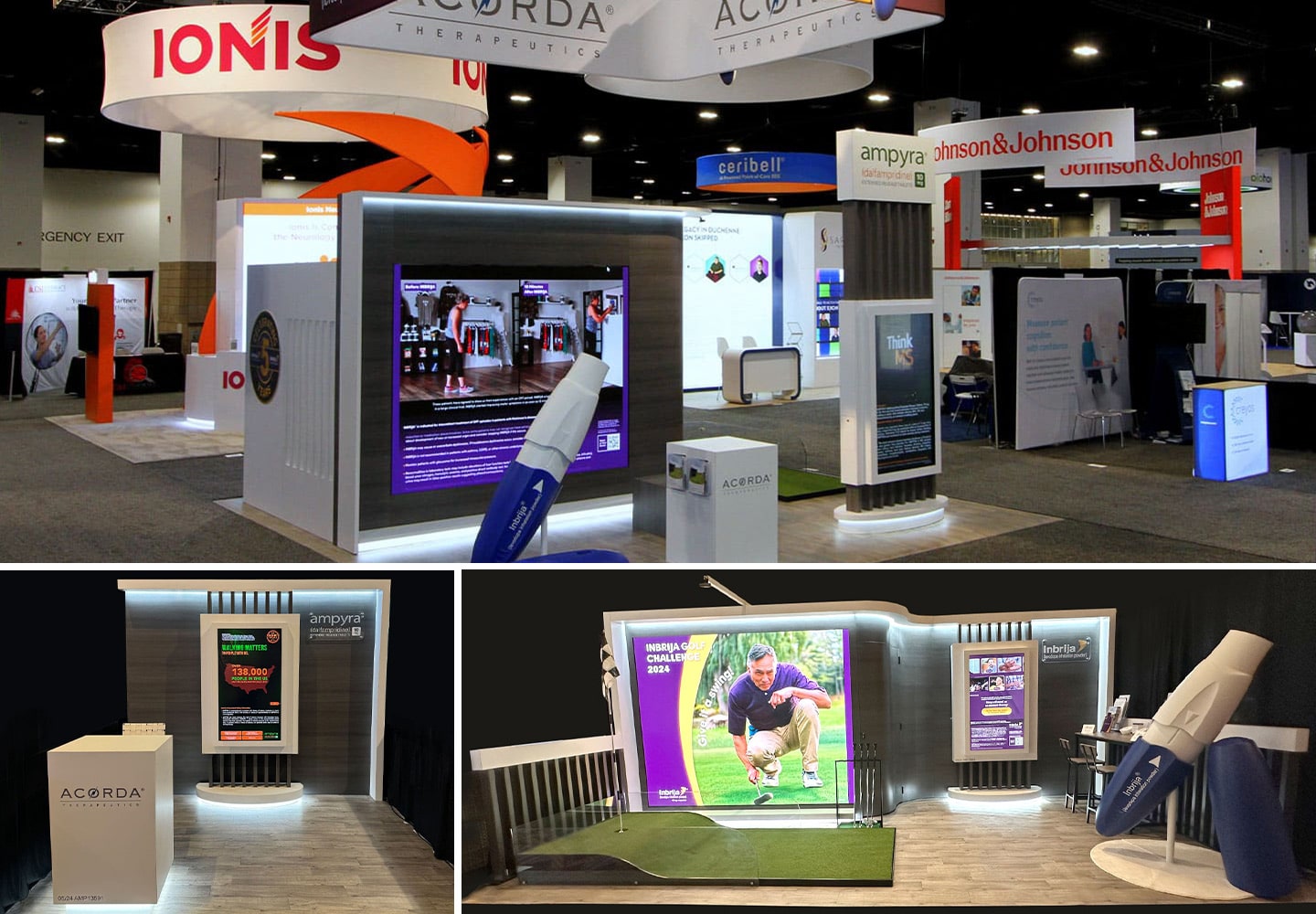In today’s dynamic healthcare business environment, agility is essential. The companies that can pivot quickly and efficiently as needed are the ones that succeed.

Healthcare companies also need to be agile when it comes to exhibiting at tradeshows. The traditional strategies of either having one tradeshow booth and finding a way to “make it work” in any footprint or bearing the expense of having multiple booths are quickly being replaced by a more cost-effective and eco-friendly approach: modular tradeshow booths.
Companies are learning that by first determining the functionality required for a tradeshow booth and then considering which fabrication option or options will meet their needs, they can have a tradeshow presence that is as flexible as it is impactful. Just as importantly, they can create continuity across multiple touchpoints.
The Drawbacks of Conventional Tradeshow Booths
To truly appreciate the advantages of modular booths, it helps to first understand the challenges of relying on an inflexible, traditional hard-panel booth. While these structures can be beautiful and functional, they come with several inherent limitations, including:
- Lack of flexibility. This is the heart of the problem. A tradeshow booth designed to be erected in only one way imposes significant limitations on how and where it can be used.
- Upfront + show-specific costs. Investing in a tradeshow booth that’s difficult (or impossible) to reconfigure to work in a smaller footprint than it was designed for can be painful. Both the people who will use the booth and those who greenlight its development know that there will likely be additional expenses associated with exhibiting at certain shows because the new booth won’t work there.
- Higher shipping and storage costs. The components of conventional tradeshow booths tend to be bigger, bulkier, and more expensive to transport and store.
- Complicated installation and dismantling. Traditional booths can be more challenging to put up and take down, requiring specialized labor and more time and expense.
- Environmental impact. Companies may have to “scrap” a conventional booth when they change their marketing tactics and the structure no longer works for the shows they want to attend. Plus, a conventional booth is usually discarded in its entirety, as phased replacement of worn or damaged areas typically isn’t an option.
The Many Advantages of Modular Tradeshow Booths
To be clear: Conventional tradeshow booths aren’t going away anytime soon. Some companies find that they meet their needs well. However, many organizations are finding the adaptability, cost-effectiveness, and sustainability of modular booths to be persuasive reasons to move in that direction.
Modular booths can be constructed in various ways, including using aluminum extrusion and tension fabric, lightweight panels made from acrylic, PVC, or polycarbonate, and engineered wood. In many cases, companies leverage a blend of traditional hard panel booth elements and modules made with newer materials and methods.
Whatever manufacturing approach is used, modular booths offer:
Unparalleled flexibility
Modular booths can be configured to meet virtually any space restrictions or show floor plans. They also accommodate different show strategies, such as components standing alone to make a statement or working in concert to, for example, explain how a company developed its newest drug or device.
Long-term economic advantages
The initial cost of modular booth components will vary, but their reusability and adaptability can provide significant savings over time.
Simplified assembly and removal
Setup teams often prefer working with modular booths, as the setup and breakdown are significantly faster and easier.
Enhanced sustainability
Modular tradeshow booths are designed and built for longevity. Components can be replaced, added, or modified with ease.
Marketing/sales peace of mind
Modular booths essentially eliminate a common question among marketing and sales teams: “Will our booth even work at this show?” Marketing and sales staff can be confident that they’ll have an attractive, functional space at every event.

Fully Modular to Hybrid Approaches With an Eye Toward the Future
Healthcare organizations leverage modular tradeshow booths in various ways. Some clients get considerable benefits from going fully modular.
They can mix and match booth components to adapt to any space without losing brand consistency or recognition.
In one client’s case, we developed individual product kiosks that can function independently or connect to tell a story like a chessboard.
Other healthcare companies adopt an economical hybrid approach. They have some conventional components (walls, signage, branding, etc.) that they can augment with custom kiosks or even exhibit company rentals as needed to create booths that take the shape of a particular space or meet a functional need.
In either case, modularity is a forward-looking strategy that enables businesses to adapt quickly, cost-effectively, and sustainably to future requirements.
Modular Design Expertise Makes All the Difference
Healthcare companies looking to leverage a modular tradeshow booth for maximum flexibility shouldn’t think that this approach eliminates the need for design expertise. On the contrary—developing a modular system that works across many footprints and show environments requires a deep understanding of everything from marketing goals and strategies to tradeshow rules and regulations.
Our team at Slate360 has that background. In fact, our design for Selux Diagnostics made us a top-three finalist for Most Innovative Use of beMatrix Products. The company’s highly regarded modular frame system is widely used in our industry, so to be recognized for our implementation of it was a tremendous honor.
The Compelling Case for Modular Tradeshow Booths
Ultimately, healthcare companies that turn to Slate360 for modular booth designs and guidance on how to capitalize on them don’t look back. The benefits of their new flexible booths are immediate and impactful.
We work closely with them to understand their company’s business objectives, tradeshow goals, and preferences on booth design and fabrication. Using that information, we advise them on how to proceed, drafting designs, polishing them based on client feedback, and overseeing the creation of the structure. Increasingly, the end result is a modular booth made from lightweight materials.
Cutting-edge modular systems provide an unmatched professional presentation. If “modular” brings to mind the image of old-school pipe-and-drape setups, these solutions are anything but that.
A well-designed modular booth also ensures brand consistency. Whether in the smallest or largest footprints, attendees immediately recognize the company and feel a sense of continuity from past shows.
Going modular also helps onsite teams focus more on engagement. They know that the booth will support their efforts, regardless of how they choose to arrange the elements to optimize traffic flow and engagement.
Then, there are the logistical and financial benefits. Modular booths can be transported, stored, erected, and disassembled far easier and more cost-effectively than conventional booths. They also are a future-proof investment that can be rapidly scaled or adapted to changing marketing needs.
Whether you’re ready to make the move to a modular design or are just starting your research but intrigued by the prospect, we encourage you to contact Slate360 today. We can tell you about recent projects, show you photos of some of our innovative modular designs, and answer questions about how a modular booth (or a blend of traditional and modular approaches) could enhance your marketing efforts.
